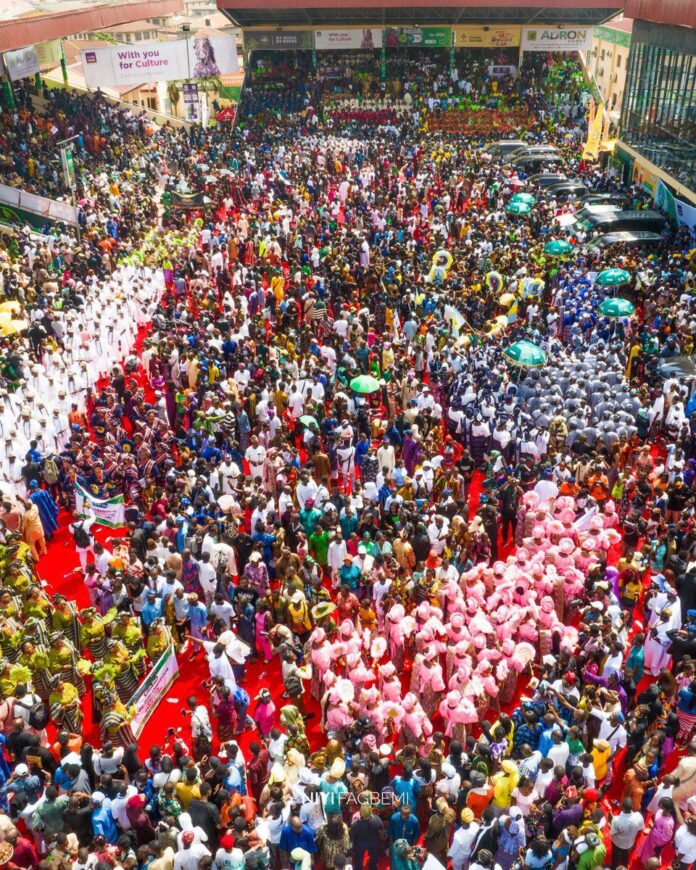Every year, the bustling town of Ijebu-Ode in Ogun State transforms into a cultural epicentre that captivates both locals and visitors from around the globe. But Ojude Oba 2025 did more than maintain tradition—it shattered attendance records, strained every inch of the existing infrastructure, and sparked urgent calls for a bold expansion plan.
In this piece, we’ll unpack what truly happened this year: the stunning size of the crowd, the spectacle that wowed millions, the critical cracks in venue capacity, and the rising chorus demanding a purpose-built cultural arena. If you’ve ever wondered how a community festival can grow so big it tests a city’s limits, this is your front-row seat to the real story.
The Massive 2025 Turnout
By dawn on June 18, 2025, it was clear Ojude Oba wouldn’t just match previous years—it would eclipse them. Police estimates and local reports indicated that over 200,000 people packed the Utoro Centre and the palace forecourt, with unofficial counts claiming over 3 million people spread across Ijebu-Ode and its suburbs. Digital reach skyrocketed, with over 100 million views from live streams, YouTube uploads, Facebook Lives, and TikTok clips shared by both locals and diaspora communities.
This was no ordinary crowd. It included royal dignitaries, age-grade societies known as regberegbe, horse riders from noble lineages, brand sponsors, and tens of thousands of spectators who travelled from within Ogun State, other Nigerian cities, and countries like the UK, US, and Canada.
Hotels sold out days before the event. Local transport doubled its fares. Mobile network providers scrambled to keep signals strong as festival-goers flooded social media with photos, live updates, and video reels of the regberegbe parades and equestrian displays.
While many festivals struggle for relevance, Ojude Oba’s biggest challenge in 2025 was being too popular for its physical space.
What Makes Ojude Oba So Special
To understand why people endure the heat and the crush of humanity just to attend Ojude Oba, you have to grasp its unique blend of history, identity, and spectacle.
Ojude Oba, which means “The King’s Forecourt,” is a thanksgiving festival celebrated by the Ijebu people. It dates back over a century, originally founded as a gathering where Muslim converts would pay homage to the Awujale—the traditional ruler of Ijebuland—after the Eid-el-Kabir prayers.
Over the decades, it evolved. Today, it’s a multi-faith, inclusive affair, blending Islamic, traditional Yoruba, and community elements into a vibrant carnival of colour, music, and horsemanship.
The main highlight is the regberegbe parade—organised age-grade societies dressed in matching Aso Oke or lace, dancing to drums, singing praise chants, and bearing lavish gifts to the Awujale. Then come the horse riders: royal families and nobles, mounted on elaborately adorned horses, performing dramatic gallops and skillful stunts to cheers from the sea of spectators.
Modern corporate sponsors like Globacom, First Bank, and Nigerian Breweries now inject branding and glitz. Yet, despite this commercial layer, the core remains rooted in respect for the Oba and a deep celebration of Ijebu heritage.
Choked Spaces and Security Gaps
With over 200,000 people squeezed into a venue originally meant for about 50,000, tension was unavoidable. In 2025, reports confirmed multiple fainting incidents due to heat and restricted airflow near the palace grounds. A minor stampede occurred when an overexcited crowd surged forward to get a glimpse of the Awujale greeting the regberegbe.
Emergency responders, including Red Cross volunteers and local health workers, worked tirelessly but were clearly overwhelmed. Makeshift clinics ran out of basic supplies like drinking water and glucose drips before the parade even peaked.
Security personnel were stretched thin trying to manage the multiple gates, maintain order among horse riders and spectators, and protect high-profile guests from pickpockets or overzealous fans. Many locals described the movement in and out of the arena as a “slow crawl,” with some families abandoning their spots hours before the finale to avoid getting trapped.
These painful realities are a sharp contrast to the festival’s reputation for flawless pomp. But as more people attend each year, the outdated arena simply can’t cope.
Local Voices: Frustration and Pride
Talk to any Ijebu son or daughter, and you’ll hear two things: immense pride in Ojude Oba’s global fame, and real frustration about the physical hardship that fame now brings.
Many locals vented online about how they spent more time battling crowds than enjoying the regberegbe dances or the horses. Traders along the main approach roads complained that human bottlenecks slowed sales as crowds became nearly immovable. Hotel and event venue owners worried that tourists may skip future editions unless congestion is addressed.
But alongside these grievances is an unshakeable sense of cultural pride. Most people agree they’d rather fix the problems than see Ojude Oba shrink back into a small-town festival. As one elder said after the event: “We have outgrown this small forecourt. Let us expand, not retreat.”
Economy vs. Capacity
Economically, Ojude Oba is a goldmine. In 2025 alone, hotels within Ijebu-Ode and neighbouring towns were booked solid, with some charging triple the normal rates. Restaurants and roadside food vendors saw record sales. Tailors who sewed regberegbe uniforms reported fully booked schedules months in advance. Even transporters made a killing, ferrying visitors from Lagos, Abeokuta, and beyond.
Corporate sponsors like Globacom, First Bank, and Nigerian Breweries pour millions into branding, stage setups, banners, and VIP lounges. Local businesses, from souvenir sellers to cultural performers, enjoy a huge boost in income that trickles down to the wider Ijebu economy.
But for all this money swirling around, the basic infrastructure remains stuck in the past: narrow roads, limited parking, poor signage, and a single arena that cannot safely hold the festival’s real capacity. Experts warn that unless the city reinvests festival revenue into modern facilities, economic benefits could stall under the weight of crowd chaos.
Calls for Expansion
In the wake of the 2025 overcrowding, the push for a purpose-built Ojude Oba Arena is louder than ever. Cultural advocates like Barrister Wale Ojo-Lanre, former Ogun State Tourism Board DG, argued forcefully that it’s time for a permanent arena with a minimum 500,000 standing capacity, structured entrance and exit points, VIP and press decks, robust security outposts, and emergency medical stations.
Governor Dapo Abiodun, whose administration is focused on infrastructural overhaul in Ogun State, acknowledged the urgent need. In a press briefing, he described Ojude Oba as a “cultural gold mine” that must now match world-class event standards.
Key stakeholders suggest three immediate actions: re-engineer traffic flow with multiple access routes; expand the arena with modular seating that can grow as attendance grows; and involve private investors to fund the new structure while preserving cultural control under the Awujale’s palace authority.
In other words: the heart of Ojude Oba must remain sacred, but the arms and legs need to be built for today’s reality.
Navigating Cultural Growth
Managing a festival that stays true to its heritage while embracing modern growth is not simple. Many cultural custodians fear that over-commercialisation might dilute the essence of Ojude Oba. For instance, the traditional horse riding is deeply symbolic, representing bravery and royalty—some elders worry that increasing sponsorship signage and reality-TV style coverage could reduce this to mere showbiz.
To strike the right balance, stakeholders are pushing for a hybrid approach. This means modern crowd management systems—such as ticketing certain vantage points to limit stampedes—combined with strict cultural protocols that ensure regberegbe remain community-led and not corporate-owned.
There’s also talk of digital innovations. A few Ijebu entrepreneurs have floated the idea of a dedicated Ojude Oba mobile app: offering live streams for those who can’t attend in person, virtual backstage tours for diaspora communities, and a donation platform to fund the new arena without compromising cultural autonomy.
One thing is clear—while the crowd has grown to record highs, there is an equally strong will to ensure that Ojude Oba remains not just a mega tourist event, but a living, breathing declaration of Ijebu dignity and unity.
Sustaining the Spirit for the Future
Ojude Oba 2025 has proven one undeniable fact: the festival is bigger than the venue that holds it. The record-breaking crowd is both a blessing and a wake-up call. From the humble palace forecourt to a possible world-class arena, the core spirit—thanksgiving, unity, and the regal bond between the Awujale and his people—must not get lost in the logistics.
The onus now lies on local leaders, cultural custodians, corporate sponsors, and indeed every Ijebu son and daughter to champion smart, sustainable expansion. This means not just erecting concrete and metal, but preserving the customs, the chants, the drums, the galloping horses, and the warm sense of homecoming that makes Ojude Oba more than a festival—it is the heartbeat of Ijebu identity.
In years to come, when future generations gather in a grander arena, with more space and less pushing, the hope is that they will still feel what every elder feels today: that Ojude Oba is theirs, and will always be a testament to how a people can grow without losing themselves.
So, whether you stood shoulder-to-shoulder in the record-breaking 2025 crowd or watched from afar on a phone screen, one truth remains: Ojude Oba is not just a festival—it’s a living promise that heritage can thrive, even as it expands beyond its original courtyard.


